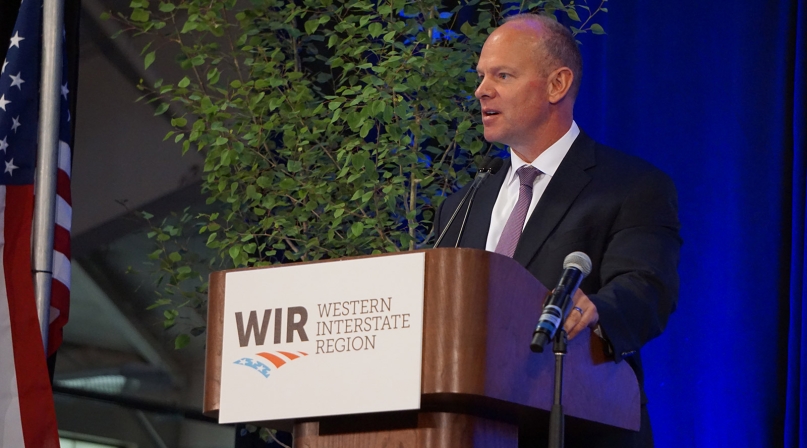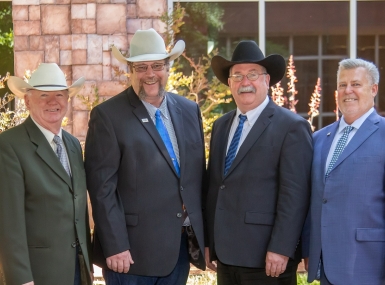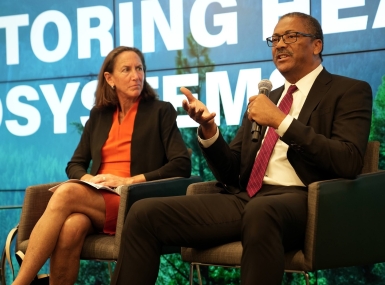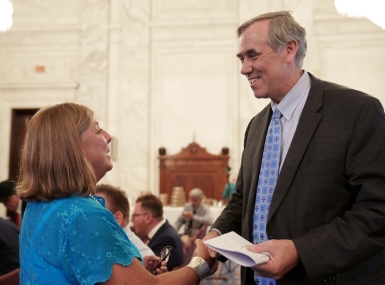WIR speakers put Western values in a national context

Wyoming Gov. Matt Mead returned to his native county to address the WIR Opening General Session. Photo by Charlie BanFeeding wild horses and antiquated oil and gas well bonding are complicating BLM operations
Wyoming Gov. Matt Mead (R) drew a direct connection between the negative tenor of the U.S. presidential race and the lack of Western influence in the race, and offered a path out of what could be an ugly general election campaign. That both presumptive major party candidates represent New York was not lost on him.
“The debate has been about body parts, who’s ugly, what industry we’re putting out of business,” he said during the Opening General Session. “When you hear that debate, you think about Western issues. Why are we not talking more about multiple use; why are we not talking more about wildlife, challenges of healthcare in rural areas, opiate abuse; why are we not talking about the strength of the national park system, what our forest means to us, what BLM means to use in the West?"
So his answer, both — to bring civility back to the campaign and engage Western voters — was to actually address those issues at stake in many of the states in the Western Interstate Region.
Things weren’t perfect, he acknowledged, pointing out that too often states were redressing their grievances with the federal government through lawsuits, but even those measures seemed born from a lack of familiarity and common ground.
“Too often policy makers in Washington, D.C. don’t have an appreciation for what the West is like,” he said. What Western county officials could do to help, he said, was to take that message to Washington.
“You can’t imagine the impact you have going to Washington and testifying (in Congress),” he said. “It’s one thing for me to do it, but it’s more meaningful for a county commissioner to testify.
“That’s the model for partnership with local government. That’s the partnership that shows the federal government the model for getting things done,” he added.
Though most of the General Session speakers focused on the West, Scott Tranter, a partner at Optimus Consulting who worked on U.S. Sen. Marco Rubio’s (R-Fla.) campaign explained to session attendees how voter-turnout analysis informs how presidential candidates allocate their campaigning time. They trawl through years of voting records for each state to determine an area’s likely turnout rate and plan based around where a candidate’s presence will likely have the greatest impact.
He also let Western officials know their states would eventually be getting more attention in national races, thanks to westward migration
“It makes those states more competitive as these people take their political attitudes with them and it affects turnout,” he said. Starting with this election cycle, “we are going to start seeing Colorado mentioned the same way we talk about Florida, Ohio and Pennsylvania.”
And he offered some insight into the general election to county officials who might not spend their mornings watching cable news discussions.
“Look at state polls,” he said. “I look at Florida, Nevada, Arizona, a little in Ohio and Iowa. Those are the polls that are going to tell me where this is going to go.”
And he diagnosed the turnout magic ascribed to presumptive Republican nominee Donald Trump. “We’re not necessarily thinking that Trump is creating a lot of new voters, but he is motivating voters who voted in ’08 but forgot to in ’12,” he said.
From just north of Teton County’s seat in Jackson, David Vela, superintendent of Grand Teton National Park, stressed the value of cooperation among several levels of government. In particular, he mentioned the park’s work with Teton County, the Jackson Town Council and Wyoming governor’s office to develop the Moose-Wilson Corridor Comprehensive Management Plan for the southwest corner of the park. In addition to structured meetings, though, he recommended holding meetings with no set agenda to encourage more discussion and bonding among the participating groups.
Michael Connor, deputy secretary of the interior, reiterated the Obama Administration’s support for the Payment in Lieu of Taxes (PILT) program and a commitment to look for ways to create certainty and steadiness with respect to PILT payments, with a target payment date of July 1, 2016. Taking PILT out of the appropriations process, he said, would not only be good for counties with federally owned land, but it would simplify internal budgeting for the Department of the Interior.
“Counties should ensure that their System for Award Management account is active and banking information is up to date,” he said.
Shailen Bhatt, executive director of the Colorado Department of Transportation, acknowledged a transportation system rivalry with the state of Utah. He appreciated Utahans’ willingness to twice raise their gas tax and once raise the sales tax to fund transportation, suggestions that conservative Coloradans resist.
“That might fly in Boulder, they’ve never met a tax increase they don’t like, but here, that dog won’t hunt,” he said, summarizing responses.
He’s looking down the barrel of a population explosion, with a projected 2 million people moving into the Centennial State in the next 20 years, and driving on a highway system that serves nearly twice as many drivers than it was designed to carry.
“And it’s not just the population, these people are going to want to buy things, and the amount of freight is going to go through the roof,” he said.
That’s motivating Colorado's RoadX plan to integrate technology into the transportation department, whether it’s using data to analyze transportation patterns and planning accordingly or using autonomous vehicle technology to make driving safer and more efficient.
His hope is to take some of the onus off of drivers, given the overwhelming influence human error has in causing crashes, and set up Colorado’s state roads and highways to be ready for self-driving vehicles.
Feeding wild horses hurts BLM staffing budget
Bureau of Land Management Director Neil Kornze, now in his third year in the role, drew particular interest from the Opening General Session attendees.
To him, challenges presented by two variables in BLM’s purview — wells and animals — are compounded by staffing shortages.
“Despite having a record budget for the agency, we do not have a record number of bodies to work with,” he said. “We’ve lost 12 percent of our BLM team over the last few years, and much of that is because we’re spending money feeding horses.”
BLM spends $50,000 on feeding and care over wild horses’ and burros’ lifetimes, which now number more than 67,000, compared to the bureau’s target of 27,000.
“In the early 2000s, we were averaging 8,000 adoptions a year, now we struggle to put 2,000 a year into good homes,” he said. “We’ve gone from spending $40 million to feed them to $80 million, and that’s a substantial part of our budget.”
BLM is researching a fertility control methods for horses, including PZP immunocontraception, but was also launching an $11 million spay and neuter project in southeastern Oregon.
“Most people are used to saying spay and neuter about a dog or cat, but like our pets, these horses are also animals we care a great deal about, and we need to talk about this in a way that most Americans can get their arms around it,” Kornze said.
“Most Americans have never seen a wild horse, most Americans have never been out in the country where this is an issue,” he added.
Kornze said there was hope for some use of wild horses and burros by the U.S. Border Patrol; 300 have been adopted for that use in the past decade. But BLM doesn’t have legal authority to transfer control of the animals, something Kornze would like to change. Border patrol personnel have adopted the animals personally.
Kornze is also concerned about whether orphan oil and gas wells are being responsibly plugged, and BLM has developed a checklist to assess actual risk from the wells. Chief among his concerns is that the bonding values for wells have not increased since they were set during the Eisenhower Administration. The current bonding rates for a drilling company are $10,000 for one well, $25,000 for all of its wells in a state and $150,000 for all of a company’s wells in the United States.
He would like to establish a BLM Foundation to manage communication and fundraising, on par with the National Park Foundation, National Forest Foundation and National Fish and Wildlife Foundation.
Kornze also expressed his hope that the new, maligned-by-counties Planning 2.0 process would expedite the BLM planning regulation processes by breaking them up into smaller chunks.
“It seems like we take information from the scoping process and go off into a corner and come back with a plan five years later, and that thousand-page document is not particularly useful, you have a lot of problems in your county to deal with on top of sifting through the drafts.”
By releasing a 20–30-page outline, between the scoping process and the draft release, Kornze hopes to make the process more transparent to the public and open to revision. “We’ll put in front of you the basic concepts we will be exploring,” he said. “Too often we have to go back and start over,” he said, when new information would come to light. A planning process that was aimed to be five or six years ends up being a nine-, 10-, 11-year process.”
BLM staffers later held a several-hour listening session with conference attendees to get feedback on Planning 2.0.




